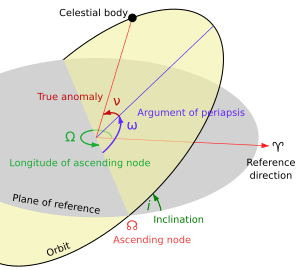Orbital plane (astronomy) facts for kids
An orbital plane is like an invisible, flat surface that a celestial body (like a planet or a moon) follows as it moves around another, larger body. Imagine a planet orbiting a star; the path it takes forms a flat circle or oval, and that flat surface is its orbital plane. It helps us understand how objects move in space.
Contents
What is an Orbital Plane?
An orbital plane is the flat area where an orbit happens. Think of it as a giant, invisible dinner plate on which a planet travels around its star. Every object orbiting another has its own orbital plane.
Why are Orbital Planes Important?
Understanding orbital planes helps scientists predict where planets, satellites, and spacecraft will be in the future. It's crucial for planning space missions and launching rockets. Without knowing these planes, it would be very hard to send a probe to Mars or keep a satellite in the right place around Earth.
Reference Planes in Space
To describe an orbital plane, we need a starting point, called a reference plane. It's like using the floor as a reference to describe how high a table is.
The Ecliptic Plane
For objects in our Solar System, the most common reference plane is the Earth's orbital plane. This is called the ecliptic plane.
- The ecliptic is the imaginary path the Sun seems to follow across the sky over a year, as seen from Earth.
- All the planets in our Solar System orbit the Sun fairly close to this ecliptic plane, like marbles rolling on a slightly tilted table.
The Invariable Plane
Sometimes, scientists use another reference called the invariable plane.
- This plane is like the average plane of the entire Solar System, taking into account the orbits of all the planets.
- It's a bit more complex, but it gives a very stable reference point for the whole system.
Examples of Orbital Planes
Let's look at some examples to make this clearer.
Planets Orbiting the Sun
Each planet in our Solar System has its own orbital plane as it circles the Sun.
- While most planets are close to the ecliptic plane, they are not perfectly flat.
- For example, Mercury's orbit is tilted about 7 degrees compared to Earth's ecliptic plane. This means its "dinner plate" is slightly angled.
Moons Orbiting Planets
Moons also have orbital planes around their planets.
- Our own Moon orbits Earth on an orbital plane that is tilted about 5 degrees relative to Earth's ecliptic plane.
- This tilt is why we don't have a solar eclipse or lunar eclipse every month! The Moon has to be exactly in the ecliptic plane for an eclipse to happen.
Satellites Orbiting Earth
Man-made satellites also follow specific orbital planes around Earth.
- Some satellites are in a geostationary orbit, meaning they stay over the same spot on Earth. Their orbital plane is usually aligned with Earth's equator.
- Other satellites, like those used for weather or spying, might be in polar orbits. Their orbital plane passes over the North Pole and South Pole on each pass.
How Orbital Planes are Described
Scientists use special numbers to describe an orbital plane's tilt and direction in space.
- One important number is the inclination. This tells us how much an orbital plane is tilted compared to a reference plane, like the ecliptic.
- An inclination of 0 degrees means the orbit is perfectly flat with the reference plane.
- An inclination of 90 degrees means the orbit is perpendicular, or straight up and down, compared to the reference plane.
See also
 In Spanish: Plano orbital para niños
In Spanish: Plano orbital para niños


